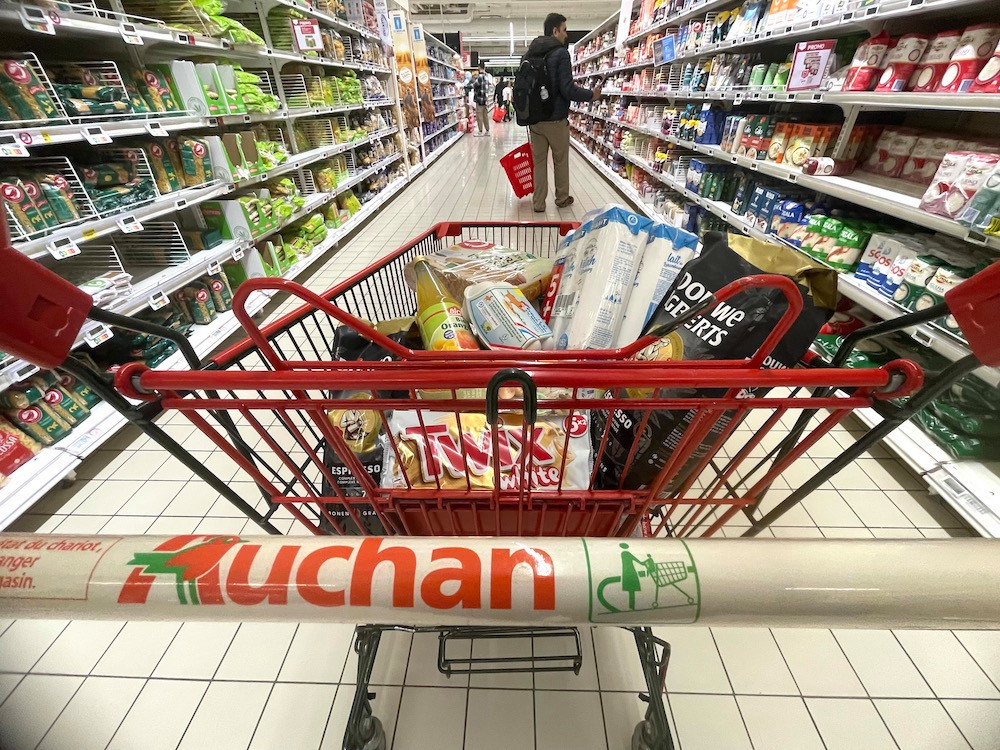The rise in the price of energy, raw materials and transport has been reflected in the products found on supermarket shelves for several months now. At the beginning of September, Luxembourg statistics bureau Statec reported a consumer price inflation of 6.8% (over twelve months), with food and non-alcoholic beverage prices rising by 8.02%.
Even if inflation is also rising in Luxembourg's neighbouring countries, the current context can make you wonder if, perhaps, the grass isn’t greener elsewhere. In other words: if shopping on the other side of the border would not be financially more interesting.
Delano’s sister publication Paperjam carried out a comparison on Tuesday 20 September, in a geographical area that lends itself perfectly to the exercise: the so-called "three borders" region (Belgium-France-Luxembourg). In that area, there are three hypermarkets in three different territories: the Cactus in Bascharage (Luxembourg), the Cora in Messancy (Belgium) and the Auchan du Pôle Europe in Mont-Saint-Martin (France). All of them are only ten minutes away from each other by car. These chains are well-established, but do not necessarily have the reputation of being the most aggressive in terms of prices.
Six-pack of water up to 82% more expensive
A shopping trolley of about 50 products was determined (see the table below), taking care to ensure that these were the same on each side of the border. This is not easy since, as the Price Formation Observatory (OFP) regularly indicates in its publications, few products are distributed everywhere throughout the Greater Region. Major international brands were favoured here, as was packaging of similar quantities. When this was not possible, similar products were chosen, while adapting the content according to the cost per litre or per kilogram.
This mini-study shows a very large difference in prices for similar products. For example, a six-pack of 1.5 litre Vittel bottles is 54% more expensive at Cactus than at Auchan on the French border and 82% more expensive compared to the Cora in Messancy. A pack of 45 Finish dishwasher tablets can be found in Belgian and Luxembourg stores at a price 77% and 122% higher than in France respectively.
It should be noted, however, that we have based ourselves on full prices for these products, not taking into account the various (large and sometimes very frequent) promotions that some of them benefit from.
Up to €70 difference
In the end, the total price of the 50 products selected in France was €287.96, i.e. 11.7% less than at the Cactus (€321.68) and 27% less than at the Cora in Messancy (€365.79).
These figures are not a generalisation, but rather a specific situation. This isn’t surprising though, says Pietro Zidda, professor of marketing at the Belgian university UNamur--he is familiar with the problems of cross-border shopping. "Today, there is a difference of almost 20% between the prices offered in France and in Belgium,” he says.
Market, cost structure and inflation
This situation can be explained by various factors. "First of all, the French food market is extremely lively. They fight like lions, with untenable outlets like Leclerc, whereas in Belgium, at least in Wallonia, it's flat in terms of aggressiveness. This competitive intensity pushes prices down," explains Zidda. "Another element is the cost structure. In the large markets, fixed costs are passed on to a larger quantity. Labour costs are also lower in France. And then there is the rampant inflation. This is reflected in the cost of raw materials, but also in wages, because in Belgium there is automatic indexation of wages.”
This is also the case in Luxembourg. Except that here, in the event of a serious economic situation, there is a possibility of temporarily avoiding the salary increase, as was the case with the postponement of an indexation tranche from July 2022 to April 2023. Still, on the subject of inflation, it should be noted that in July the consumer price index was 6.1% in France and 10.4% in Belgium. In August, Luxembourg was between the two, at 6.8%.
Finally, we can add that there are obviously differences in terms of taxation--the VAT rate on food, for example, is not the same in the three territories (3% in Luxembourg, 5.5% in France and 6% in Belgium).
Auchan vs Auchan
If the Auchan in Mont-Saint-Martin is the least expensive of the three establishments we visited, what about the shops of the same group in Luxembourg--And more precisely the Auchan Opkorn supermarket, located in Differdange, a quarter of an hour by car from the French shop?
After checking, it appears that the same shopping trolley with 50 products costs €294.96, i.e. €7 more than in France. This puts it in second place in our mini study. This can be explained, at least in part, by the fact that the Luxembourg Auchan stores are partly supplied by the French central purchasing office.
“Is it Auchan Luxembourg's intention is to align itself with the prices charged in the Mont-Saint-Martin shop? It is to align itself with the closest competition, so as to keep our local customers," the group's Luxembourg branch explained at the end of the week. No one would go so far as to say that Auchan is competing with Auchan. But in the meantime, in this tri-border region, the biggest winner is the consumer. This story was first published in French on . It has been translated and edited for Delano.
